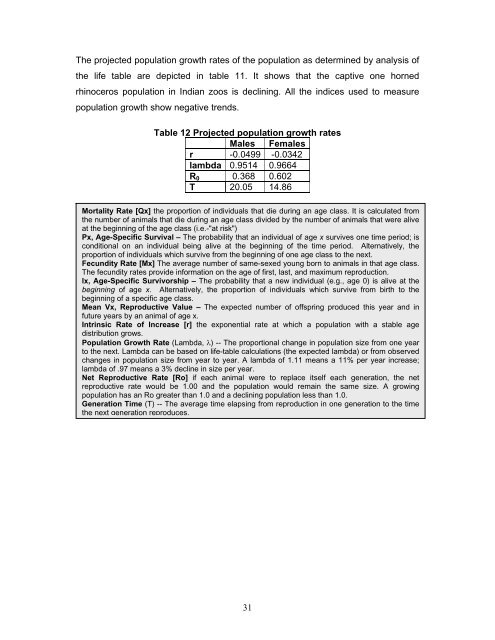Indian One horned Rhinoceros - Central Zoo Authority
Indian One horned Rhinoceros - Central Zoo Authority
Indian One horned Rhinoceros - Central Zoo Authority
You also want an ePaper? Increase the reach of your titles
YUMPU automatically turns print PDFs into web optimized ePapers that Google loves.
The projected population growth rates of the population as determined by analysis of<br />
the life table are depicted in table 11. It shows that the captive one <strong>horned</strong><br />
rhinoceros population in <strong>Indian</strong> zoos is declining. All the indices used to measure<br />
population growth show negative trends.<br />
Table 12 Projected population growth rates<br />
Males Females<br />
r -0.0499 -0.0342<br />
lambda 0.9514 0.9664<br />
R0 0.368 0.602<br />
T 20.05 14.86<br />
Mortality Rate [Qx] the proportion of individuals that die during an age class. It is calculated from<br />
the number of animals that die during an age class divided by the number of animals that were alive<br />
at the beginning of the age class (i.e.-"at risk")<br />
Px, Age-Specific Survival – The probability that an individual of age x survives one time period; is<br />
conditional on an individual being alive at the beginning of the time period. Alternatively, the<br />
proportion of individuals which survive from the beginning of one age class to the next.<br />
Fecundity Rate [Mx] The average number of same-sexed young born to animals in that age class.<br />
The fecundity rates provide information on the age of first, last, and maximum reproduction.<br />
lx, Age-Specific Survivorship – The probability that a new individual (e.g., age 0) is alive at the<br />
beginning of age x. Alternatively, the proportion of individuals which survive from birth to the<br />
beginning of a specific age class.<br />
Mean Vx, Reproductive Value – The expected number of offspring produced this year and in<br />
future years by an animal of age x.<br />
Intrinsic Rate of Increase [r] the exponential rate at which a population with a stable age<br />
distribution grows.<br />
Population Growth Rate (Lambda, λ) -- The proportional change in population size from one year<br />
to the next. Lambda can be based on life-table calculations (the expected lambda) or from observed<br />
changes in population size from year to year. A lambda of 1.11 means a 11% per year increase;<br />
lambda of .97 means a 3% decline in size per year.<br />
Net Reproductive Rate [Ro] if each animal were to replace itself each generation, the net<br />
reproductive rate would be 1.00 and the population would remain the same size. A growing<br />
population has an Ro greater than 1.0 and a declining population less than 1.0.<br />
Generation Time (T) -- The average time elapsing from reproduction in one generation to the time<br />
the next generation reproduces.<br />
31

















